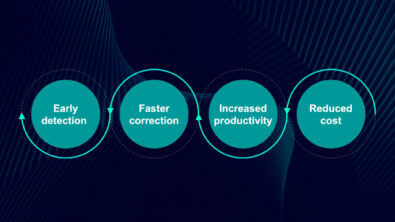SAMP series finishes with SAMP cut mask decomposition techniques

By David Abercrombie and Rehab Kotb Ali – Mentor, A Siemens Business
We’ve been writing about self-aligned multi-patterning (SAMP) topics for some time now. We hope this information has been useful to you, from understanding how SAMP enables production at the most advanced nodes, to learning about the differences in SAMP technologies, to enabling you to use Calibre tools to accurately decompose and prepare designs for manufacturing. Our collaboration with IMEC has allowed us to delve into these topics in depth, and bring you real-world examples of the SAMP processes in action.
Our previous paper addressed the techniques that can be used to generate the track masks needed to manufacture a SAMP design. Our final paper in this series examines the techniques and technologies used to create the cut (block) masks needed to produce a final design that can be manufactured using SAMP processes.
The three SAMP processes— SADP, SAQP and SALELE—all require cut masks to define the line ends of metal target shapes, and to provide the proper electrical isolation between metal target shapes. Generating cut masks for metal layers is a demanding process, because the cut shapes are added in the gaps between metal target shapes. All process constraints, including cut width, minimum/maximum cut length, minimum tip-to-tip, side-to-side, and corner-to-corner spacing between cut shapes, minimum via enclosure distances, and minimum metal area between cut shapes, must be respected when adding metal shapes. At the same time, designers can’t yet see where the final cuts will need to be placed!
In addition to these basic constraints, foundries may add specific rules to enhance printability. After that, there are always the optimizations that can enhance manufacturing robustness. In the end, designers must strive to satisfy all the required constraints, and as many optional spacing constraints as possible.
In our latest technical paper, Self-aligned multi-patterning cut/block mask decomposition techniques, we explain the various types of constraints applied to cut masks, the challenges designers face when trying to ensure compliance and optimization, and the techniques and strategies they can employ to achieve success. We show you how implementing an automated cut mask generation solution with the Calibre Multi-Patterning tool offers a huge time savings to design teams, as well as potential yield improvement through the optimization of cut placement features.
We hope you’ve found our SAMP series useful and educational! Joint development projects such as this one between IMEC and Mentor contribute to innovative and comprehensive automated EDA solutions that provide wide-ranging benefits to both IC design companies and foundries. If you’ve missed any of the papers in the series, here is the complete list:
- Multi-patterning options for 5nm and below: SADP, SAQP, SALELE
- Comparing multi-patterning at 5nm: SADP, SAQP, and SALELE
- Self-aligned multi-patterning track decomposition techniques
- Self-aligned multi-patterning cut/block mask decomposition techniques
Don’t forget to visit the Calibre website for even more information on multi-patterning technologies and resources.


